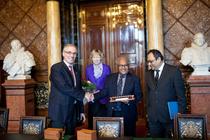Agreement opens up top-class light sources to the Indian science community
Today (21.12.2011), in the Hamburg City Hall, an agreement was signed in the presence of Hamburg’s Science Senator and Second Mayor Dr. Dorothee Stapelfeldt that defines Indian participation at the X-ray sources PETRA III and FLASH. With this, the contracting partners DESY and Saha Institute of Nuclear Physics (SINP, India) concretise a general cooperation agreement which was concluded in May this year during the visit of Chancellor Angela Merkel to India. For five years, more than 3500 hours of measuring time at DESY research facilities will be made available to Indian scientists for their own and for joint research projects with DESY. In return, India contributes with a total of 14 million euros to the construction of the PETRA III extension at DESY, the world’s most brilliant synchrotron radiation source.

Professor Helmut Dosch, Chairman of the DESY Board of Directors: “This is a classical win-win situation. Large-scale research always was a forerunner of international cooperation, and at our top-class light sources, we bring together extremely talented and dedicated scientists from India and Germany.”
DESY’s modern synchrotron radiation source PETRA III and the world’s first free-electron laser for soft X-ray light FLASH offer unique research possibilities and a great potential for innovative scientific experiments. Therefore, they are extremely attractive for the well-developed and highly qualified science community of India. PETRA III, which took up regular user operation in 2011, currently provides 14 beamlines of highly-intensive X-ray light for research. From 2013 to 2014, the facility will be extended with two additional experimental halls, hosting another ten beamlines in total.
India is planning to build an own synchrotron radiation source of the third generation for high-energy photons; thus, the country is very much interested in training young scientists at the DESY experimental facilities.
Dr. Dorothee Stapelfeldt, Second Mayor and Senator for Science and Research: “I am very glad that the cooperation agreement between DESY in Hamburg and Saha Institute of Nuclear Physics (SINP) in Kolkatais now successfully concluded. Already for several years, Indian scientists and DESY have been working together. The next important step is to further intensify this cooperation and to offer Indian scientists the possibility to participate in nano and materials science experiments. Particularly nanotechnology will be one of the key technologies of the 21th century. Nanotechnology has the potential to find important technological solutions for the major social challenges of our times, for example in the field of energy supply and climate protection. I am sure that this agreement is advantageous for both parties and will offer many new insights.”
Furthermore, DESY and SINP are discussing whether there are possibilities for additional cooperation in the field of particle physics and accelerators’ instrumentation.
—-
Source: DESY press release dated 21.12.2011

